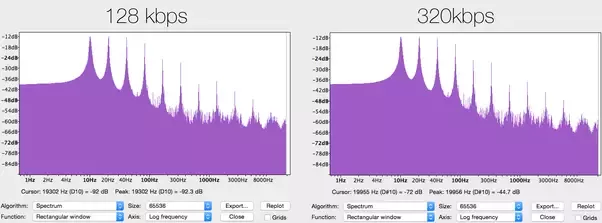

- #320 KBPS MP3 QUALITY HOW TO#
- #320 KBPS MP3 QUALITY SOFTWARE#
While talking about compression rates we’ll use it as an example.
#320 KBPS MP3 QUALITY SOFTWARE#
Still, MP3 continues to be widely used because most of the software and equipment were developed for this format. m4a extensions) allow for even smaller files with better quality. Speaking of MP3, despite its great popularity, this format is currently considered obsolete, since others, such as ACC (. Depending on the compression mode, we can generate an MP3 from a WAV file and have a file that is 10 times smaller, without perceptible changes to the sound. Through a complex algorithm, such files are created by maintaining only the information that is relevant to our ears. These files are what JPEG or GIF formats are to images.


Some examples of these formats are: 3GP, AAC, M4A, OGG, WMA and MP3, which is without a doubt the best known. These files are more convenient, easy to process and require less storage space, having very small file sizes (in bytes). Most of the equipment available on the market (cameras, cellphones and even audio recorders) usually deliver files already compressed. Thus, by using plugins, conversions, and processing, you can manipulate them more freely, ensuring excellent quality, even if a compressed file is generated afterwards. Because they hold a lot of information, they support more extreme changes without audio loss. However, even if you’re not interested in finishing the process as a WAV (one of the most common), lossless formats can be quite useful during the editing step.
For the audiophile market (due to perceived value and to ensure high quality). When it’s intended for physical media (CD, DVD e Blue-Ray) or. When the final product can be processed by consumers (files used in audio banks, for example). Since the files are usually quite large, the use of these lossless formats in the final product is only recommended in certain cases, such as: For those who are familiar with photography, they are equivalent to RAW or DNG. These uncompressed files can be created in several formats and extensions, such as WAV, AIFF, FLAC and ALAC. Uncompressed filesĭedicated audio recording equipment usually give us options for recording files without any loss of information. This is where many things come into play, such as technical specifications and even relationships with patents.Īs to the files, they are usually divided into two types: uncompressed or compressed. These format and codec variations depend on choices from the companies that develop the software that run the files. In this case, the solution would be to use other software to read the file or perform a conversion (new encoding), which can be performed in video editors. This situation may indicate that the codecs used were different. This information is valid so you don’t get lost if you don’t understand why the software you usually use to play your *.m4a files suddenly refuses so play another one with same extension, for example. These extensions get mixed up, but the important thing to know is that, just like videos, files with the same type of extension don’t always have the same codec and vice versa. ), which usually tells us how the file was encoded, or its codec.įor example, a file in MP3 format has a *.mp3 extension and MPEG-1 Audio Layer III codec. In a simple explanation, format is merely the type of file, identified in its extension ( *.mp3, *.wav, *.ogg, *.wma, etc. When referring to audio files we use terms such as formats, extensions and codecs. Formats, extensions, and codecs: What do they mean? We’ll also talk about the possibility of higher compression to podcast files, which can be created in mono MP3 format with 64 kbps, facilitating online access. In addition, you’ll also know why in most cases we won’t need more than an MP3 format with 192 kbps to export audio with excellent quality. In short, you’ll understand why we recommend recording in an uncompressed format ( WAV, for example) at 24 bits and 48 kHz. Thus, you’ll be more confident about your choices regarding audio quality and ensure good results. In this article, we’re going to talk about the differences between sample rates, bit depth, file compression rates and format variations. #320 KBPS MP3 QUALITY HOW TO#
But if you’re going to work with videos or podcasts, you better know how to interpret these parameters when recording or exporting files, whether on Audacity (free), Reaper, Adobe Audition or even on video editors. Audio quality for recorders or interfaces can be quite confusing.







 0 kommentar(er)
0 kommentar(er)
